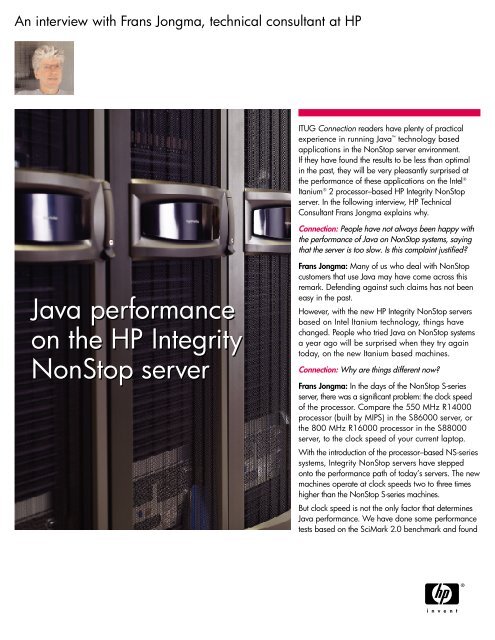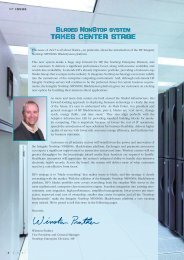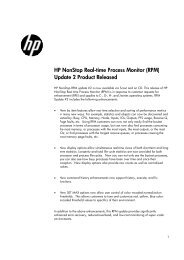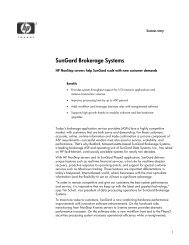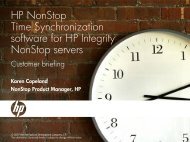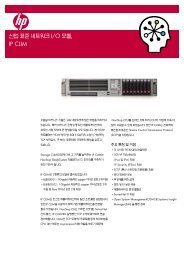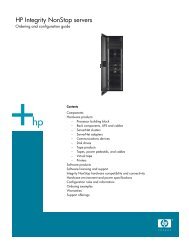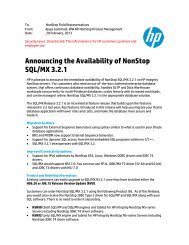Java performance on the HP Integrity NonStop server Java ...
Java performance on the HP Integrity NonStop server Java ...
Java performance on the HP Integrity NonStop server Java ...
Create successful ePaper yourself
Turn your PDF publications into a flip-book with our unique Google optimized e-Paper software.
An interview with Frans J<strong>on</strong>gma, technical c<strong>on</strong>sultant at <strong>HP</strong>ITUG C<strong>on</strong>necti<strong>on</strong> readers have plenty of practicalexperience in running <str<strong>on</strong>g>Java</str<strong>on</strong>g> technology basedapplicati<strong>on</strong>s in <strong>the</strong> N<strong>on</strong>Stop <strong>server</strong> envir<strong>on</strong>ment.If <strong>the</strong>y have found <strong>the</strong> results to be less than optimalin <strong>the</strong> past, <strong>the</strong>y will be very pleasantly surprised at<strong>the</strong> <str<strong>on</strong>g>performance</str<strong>on</strong>g> of <strong>the</strong>se applicati<strong>on</strong>s <strong>on</strong> <strong>the</strong> Intel ®Itanium ® 2 processor–based <strong>HP</strong> <strong>Integrity</strong> N<strong>on</strong>Stop<strong>server</strong>. In <strong>the</strong> following interview, <strong>HP</strong> TechnicalC<strong>on</strong>sultant Frans J<strong>on</strong>gma explains why.C<strong>on</strong>necti<strong>on</strong>: People have not always been happy with<strong>the</strong> <str<strong>on</strong>g>performance</str<strong>on</strong>g> of <str<strong>on</strong>g>Java</str<strong>on</strong>g> <strong>on</strong> N<strong>on</strong>Stop systems, sayingthat <strong>the</strong> <strong>server</strong> is too slow. Is this complaint justified?<str<strong>on</strong>g>Java</str<strong>on</strong>g> <str<strong>on</strong>g>performance</str<strong>on</strong>g><strong>on</strong> <strong>the</strong> <strong>HP</strong> <strong>Integrity</strong>N<strong>on</strong>Stop <strong>server</strong>Frans J<strong>on</strong>gma: Many of us who deal with N<strong>on</strong>Stopcustomers that use <str<strong>on</strong>g>Java</str<strong>on</strong>g> may have come across thisremark. Defending against such claims has not beeneasy in <strong>the</strong> past.However, with <strong>the</strong> new <strong>HP</strong> <strong>Integrity</strong> N<strong>on</strong>Stop <strong>server</strong>sbased <strong>on</strong> Intel Itanium technology, things havechanged. People who tried <str<strong>on</strong>g>Java</str<strong>on</strong>g> <strong>on</strong> N<strong>on</strong>Stop systemsa year ago will be surprised when <strong>the</strong>y try againtoday, <strong>on</strong> <strong>the</strong> new Itanium based machines.C<strong>on</strong>necti<strong>on</strong>: Why are things different now?Frans J<strong>on</strong>gma: In <strong>the</strong> days of <strong>the</strong> N<strong>on</strong>Stop S-series<strong>server</strong>, <strong>the</strong>re was a significant problem: <strong>the</strong> clock speedof <strong>the</strong> processor. Compare <strong>the</strong> 550 MHz R14000processor (built by MIPS) in <strong>the</strong> S86000 <strong>server</strong>, or<strong>the</strong> 800 MHz R16000 processor in <strong>the</strong> S88000<strong>server</strong>, to <strong>the</strong> clock speed of your current laptop.With <strong>the</strong> introducti<strong>on</strong> of <strong>the</strong> processor–based NS-seriessystems, <strong>Integrity</strong> N<strong>on</strong>Stop <strong>server</strong>s have stepped<strong>on</strong>to <strong>the</strong> <str<strong>on</strong>g>performance</str<strong>on</strong>g> path of today’s <strong>server</strong>s. The newmachines operate at clock speeds two to three timeshigher than <strong>the</strong> N<strong>on</strong>Stop S-series machines.But clock speed is not <strong>the</strong> <strong>on</strong>ly factor that determines<str<strong>on</strong>g>Java</str<strong>on</strong>g> <str<strong>on</strong>g>performance</str<strong>on</strong>g>. We have d<strong>on</strong>e some <str<strong>on</strong>g>performance</str<strong>on</strong>g>tests based <strong>on</strong> <strong>the</strong> SciMark 2.0 benchmark and found
significant <str<strong>on</strong>g>performance</str<strong>on</strong>g> improvements—up to a factorof 7—between <strong>the</strong> new Itanium processor–basedsystems and previous high-end N<strong>on</strong>Stop S-seriesmachines. So it’s not <strong>on</strong>ly about raw megahertzfigures. The CPU architecture plays an importantrole, too.C<strong>on</strong>necti<strong>on</strong>: What are <strong>the</strong> characteristics of thatSciMark benchmark, and how relevant is it forbusiness applicati<strong>on</strong>s?FJ: SciMark was developed by Roldan Pozo andBruce Miller of <strong>the</strong> Nati<strong>on</strong>al Institute of Standardsand Technology (NIST). The goal was to get a betterunderstanding of <strong>the</strong> behavior of <strong>the</strong> <str<strong>on</strong>g>Java</str<strong>on</strong>g> VirtualMachine (JVM) and <strong>the</strong> compiler technology it usesto interpret, compile, and optimize <str<strong>on</strong>g>Java</str<strong>on</strong>g> code. Thetests are simple computati<strong>on</strong>s that are d<strong>on</strong>e in asingle-threaded fashi<strong>on</strong>. It is quite a good test forcomparing <strong>the</strong> N<strong>on</strong>Stop Server for <str<strong>on</strong>g>Java</str<strong>on</strong>g> JVM witho<strong>the</strong>r JVMs running <strong>on</strong> o<strong>the</strong>r platforms.It is important to bear in mind that SciMark is a verysimple test and can’t reflect <strong>the</strong> behavior of complexbusiness applicati<strong>on</strong>s. But sometimes it can take a verybig effort to evaluate simplistic <str<strong>on</strong>g>performance</str<strong>on</strong>g> claims,and referral to <strong>the</strong> SciMark benchmark may be agreat help in such cases.The SciMark tests show that we do not have to shyaway from tests that are simple to execute and do notreflect real-world applicati<strong>on</strong>s. That said, of course, realvalue certainly comes from testing real applicati<strong>on</strong>s.FJ: Standardizati<strong>on</strong> of comp<strong>on</strong>ents has advantages inmanufacturing <strong>HP</strong>’s three strategic <strong>server</strong> lines; it alsohas <strong>the</strong> advantage of allowing us to perform closercomparis<strong>on</strong>s of <strong>Integrity</strong> N<strong>on</strong>Stop <strong>server</strong>s with o<strong>the</strong>r<strong>server</strong>s than was possible before. With <strong>the</strong> hardwarebeing much more similar today, <strong>the</strong> comparis<strong>on</strong> cannow c<strong>on</strong>centrate <strong>on</strong> <strong>the</strong> software implementati<strong>on</strong>.We have performed <strong>the</strong> same tests <strong>on</strong> Itaniumprocessor–based <strong>server</strong>s running <strong>the</strong> <strong>HP</strong>-UX operatingsystem, <strong>the</strong> N<strong>on</strong>Stop operating system, and Windows ®Server 2003. We used <strong>the</strong> same clock rate (1.6 GHz)and <strong>the</strong> same CPU cache size. The results show that<strong>the</strong> <str<strong>on</strong>g>performance</str<strong>on</strong>g> of <strong>the</strong> JVM <strong>on</strong> <strong>Integrity</strong> N<strong>on</strong>Stop<strong>server</strong>s is <strong>on</strong> par with <strong>the</strong> JVMs from BEA and <strong>HP</strong>running <strong>on</strong> <strong>HP</strong> <strong>server</strong>s with <strong>the</strong> same chipset, as isshown in <strong>the</strong> following diagram.2001801601401201008060JVM Performance test results based <strong>on</strong> SciMark 2.0In a nutshell: With <str<strong>on</strong>g>Java</str<strong>on</strong>g> technology<strong>on</strong> <strong>the</strong> <strong>Integrity</strong> N<strong>on</strong>Stop <strong>server</strong> youget roughly <strong>the</strong> same <str<strong>on</strong>g>performance</str<strong>on</strong>g>,but better service levels in terms ofreliability, availability, and security(RAS)-and you get better total costof ownership (TCO), too.C<strong>on</strong>necti<strong>on</strong>: So <str<strong>on</strong>g>Java</str<strong>on</strong>g> <str<strong>on</strong>g>performance</str<strong>on</strong>g> <strong>on</strong> N<strong>on</strong>Stopsystems has improved dramatically versus <strong>the</strong> previousN<strong>on</strong>Stop S-series machines. How does it stack upagainst o<strong>the</strong>r systems that are c<strong>on</strong>sidered more“mainstream” today?40200Win64 JRockit 1.5 N<strong>on</strong>Stop OS 1.5 <strong>HP</strong>-UX 1.52


